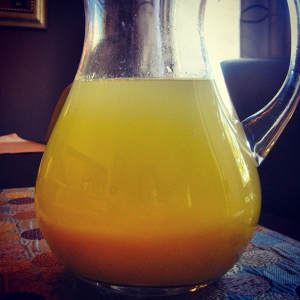Also see:
Sugar (Sucrose) Restrains the Stress Response
Calcium Paradox
Thumbs Up: Fructose
Intestinal Serotonin and Bone Loss
Bone Health and Vitamin K
Parmigiano Reggiano cheese and bone health
Calcium Paradox
Estrogen Dominance and Magnesium Deficiency
Benefits of Aspirin
Ann Nutr Aliment. 1975;29(4):305-12.
[Effects of administering diets with starch or sucrose basis on certain parameters of calcium metabolism in the young, growing rat].
[Article in French]
Artus M.
The important role of many carbohydrates on calcium metabolism has been demonstrated by FOURNIER and DUPUIS. Starch, however, neither influences the absorption nor the retention of calcium. Less is known about the effects of sucrose. In this study the influence of starch on calcium metabolsim has been compared with that of sucrose. Male weanling Wistar rats were divided into three groups according to their diets. The first group received a refined and well-balanced diet (except for the absence of vitamin D), containing 68 p. 100 of starch. The second group received the same diet except sucrose was substituted for the starch. The third group received the same diet as Group 1, with the addition of vitamin D. Plasma calcium citrate and urinary citrate and calcium were determined. At the age of 2 months after one night of fasting, each group of rats was injected intraperitoneally with a 1 ml, aqueous solution containing 1 mg calcium and 0, 6 mu Ci45Ca. Twenty-four hours later the animals were sacrificed and the calcium femur percentage, radioactivity p. 1,000 of the injected dose of 45Ca, and specific radioactivity were determined. When performance data from Group 3 were compared to Group 1 and Group 2, the following results were obtained: —Group 1 (starch diet without vitamin D) had very low plasma calcium levels; urinary calcium, plasma citrate and urinary citrate levels were lowered, and the calcium femur percentage was smaller. Bone avidity for calcium was found. –Group 2 (sucrose diet without vitamin D) had normal plasma calcium levels. Urinary calcium and citrate and plasma citrate did not show significant differences from those of animals receiving vitamin D. No significant differences were found in the specific radioactivity and radioactivity p. 1,000 of the administered dose. Contrary to starch, sucrose maintained calcium homeostasis, and apparently, normal ossification, although the femur was lighter than those of animals receiving vitamin D. Further work is necessary to determine whether the fructose component of the sucrose molecule is responsible for the increased calcium utilization and, if so, what levels of ingestion are necessary for this activity.
Bone. 2008 May;42(5):960-8. Epub 2008 Feb 15.
The effect of feeding different sugar-sweetened beverages to growing female Sprague-Dawley rats on bone mass and strength.
Tsanzi E, Light HR, Tou JC.
Consumption of sugar beverages has increased among adolescents. Additionally, the replacement of sucrose with high fructose corn syrup (HFCS) as the predominant sweetener has resulted in higher fructose intake. Few studies have investigated the effect of drinking different sugar-sweetened beverages on bone, despite suggestions that sugar consumption negatively impacts mineral balance. The objective of this study was to determine the effect of drinking different sugar-sweetened beverages on bone mass and strength. Adolescent (age 35d) female Sprague-Dawley rats were randomly assigned (n=8-9/group) to consume deionized distilled water (ddH2O, control) or ddH2O containing 13% w/v glucose, sucrose, fructose or high fructose corn syrup (HFCS-55) for 8weeks. Tibia and femur measurements included bone morphometry, bone turnover markers, determination of bone mineral density (BMD) and bone mineral content (BMC) by dual energy X-ray absorptiometry (DXA) and bone strength by three-point bending test. The effect of sugar-sweetened beverage consumption on mineral balance, urinary and fecal calcium (Ca) and phosphorus (P) was measured by inductively coupled plasma optical emission spectrometry. The results showed no difference in the bone mass or strength of rats drinking the glucose-sweetened beverage despite their having the lowest food intake, but the highest beverage and caloric consumption. Only in comparisons among the rats provided sugar-sweetened beverage were femur and tibia BMD lower in rats drinking the glucose-sweetened beverage. Differences in bone and mineral measurements appeared most pronounced between rats drinking glucose versus fructose-sweetened beverages. Rats provided the glucose-sweetened beverage had reduced femur and tibia total P, reduced P and Ca intake and increased urinary Ca excretion compared to the rats provided the fructose-sweetened beverage. The results suggested that glucose rather than fructose exerted more deleterious effects on mineral balance and bone.
Am J Clin Nutr. 1989 Jun;49(6):1290-4.
Dietary fructose or starch: effects on copper, zinc, iron, manganese, calcium, and magnesium balances in humans.
Holbrook JT, Smith JC Jr, Reiser S.
A balance study was conducted to assess the effects of consuming low-copper diets, high in fructose or cornstarch. The study involved 19 apparently healthy males, aged 21-57 y. The two experimental diets averaged 0.35 mg Cu/1000 kcal and provided 20% of the calories from fructose or cornstarch. Cu, zinc, calcium, magnesium, and iron balances were determined 1 wk before the study (pretest) when the subjects consumed self-selected diets and after consuming the experimental diets for 6 wk. No major differences in mineral balances were evident between the two groups during the pretest study when the subjects ate self-selected diets. In contrast, when fed the test diets, the group consuming the low-Cu fructose diet had significantly more positive balances for all minerals studied than the group fed the low-Cu cornstarch diet. The results indicate that dietary fructose enhances mineral balance.

